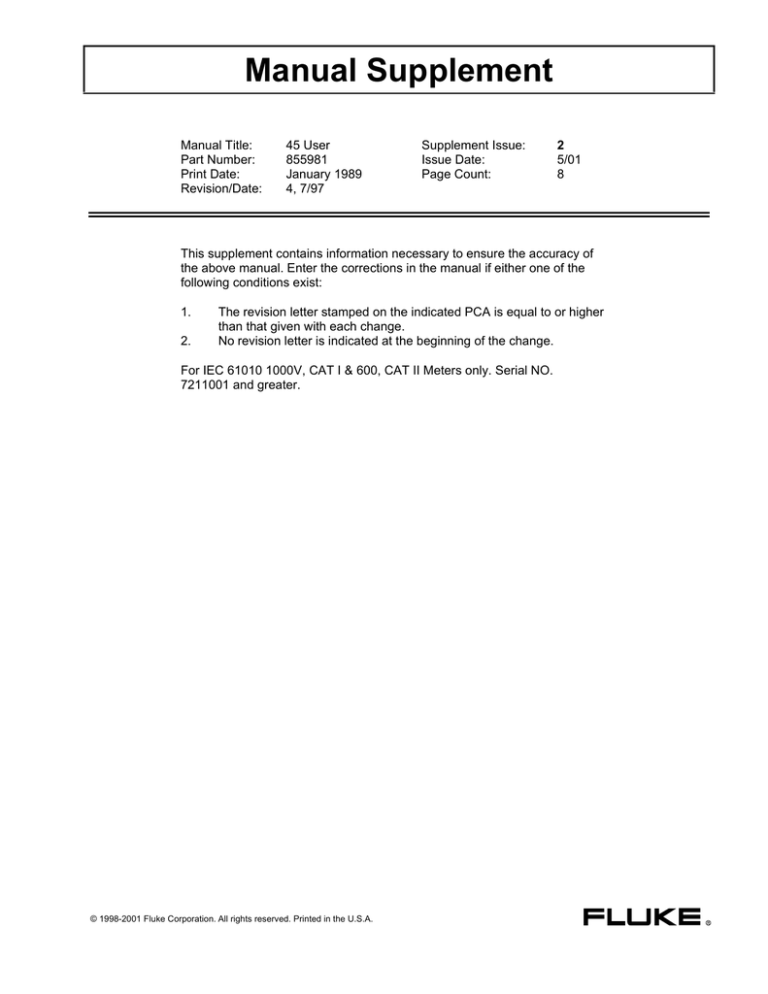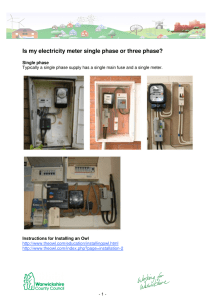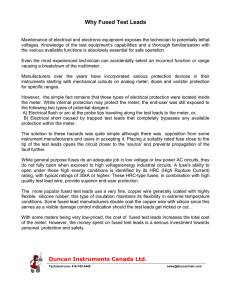
Manual Supplement
Manual Title:
Part Number:
Print Date:
Revision/Date:
45 User
855981
January 1989
4, 7/97
Supplement Issue:
Issue Date:
Page Count:
2
5/01
8
This supplement contains information necessary to ensure the accuracy of
the above manual. Enter the corrections in the manual if either one of the
following conditions exist:
1.
2.
The revision letter stamped on the indicated PCA is equal to or higher
than that given with each change.
No revision letter is indicated at the beginning of the change.
For IEC 61010 1000V, CAT I & 600, CAT II Meters only. Serial NO.
7211001 and greater.
© 1998-2001 Fluke Corporation. All rights reserved. Printed in the U.S.A.
45 User
Manual Supplement
Change #1
Throughout the manual, replace all front and rear views of the meter with the following:
Primary
Display
mA Fuse
Receptacle
Secondary
Display
45 DUAL DISPLAY MULTIMETER
V
REL AUTO
REMOTE SMF MAX dB
MIN HOLD
EXT TRG
mA
mVDCAC UNCAL mA
Mk Hz
10A
600V CAT I
1000V CAT I
!
mV DC AC
Mk Hz
CAL
ENABLE
100
mA
COM
FUSE F1
500 mA
F 250V
FUSED
Shift
Key
V
REL
A
A
V
FREQ
HI
LO
2ND
REF
HOLD
MN MX
RATE
THRESH
ADDR
BAUD
AUTO
COMP
dB
REF#
LOCAL
POWER
Input
Terminals
Ranging
Buttons
Function
Buttons
Modifier
Buttons
Reading
Rate
f2-1.eps
45 Front View
IEEE-488 Interface Connector*
RS-232 Connector
Serial Number Label
IEEE STD 488 PORT
C
R
US
LISTED
950 Z
SH1, AH1, T5, L4, SR1, RL1,
DC1, DT1, PPO, CO ,E1
RX
DTR
TX GND
IIII
1 2 3 4 5
6 7 8 9
WARNING:
TO AVOID ELECTRIC SHOCK DISCONNECT
MEASURING TERMINALS BEFORE OPENING
CASE
CAUTION:
FOR FIRE PROTECTION
REPLACE ONLY WITH
T 1/8A 250V (SLOW) FUSE
WARNING:
TO AVOID DAMAGE OR INJURY USE ONLY
IN CIRCUITS LESS THAN 4800VA
90-264V
50/60 Hz
20VA
FLUKE CORPORATION
MADE IN USA
PAT. 4,217,543 4,556,867 4,532,470 4,825,392
4,857,878 5,332,963 5,418,464 DES 311,700
RS-232C
*Available with IEEE-488
Interface Option only. Otherwise,
covered with insert
Line Power Fuse Housing
Power-Line Cord Connector
f2-1-eps
45 Rear View
11/98
1
Manual Supplement
45 User
On the page immediately following the warranty page, make the following changes:
Change the heading,
From:
SAFETY CLASS
To:
Caution
Remove the Declaration of the Manufacturer or Importer section.
Replace the MULTIMETER SAFETY page, immediately preceding Section 2, with the following:
Read First: Safety Information
This meter complies with ANSI/ISA S82.01-1994, CAN/CSA-C22.2 No.
1010. 1-92, EN61010.1:1993 to 1000 V Overvoltage Cat I, 600 V
Overvoltage Cat II and UL3111-1. Use the meter only as specified in
this Users Manual, otherwise the protection provided by the meter
may be impaired.
Use the meter as described in this manual. Otherwise the safety features provided by the meter might
be impaired. A Warning identifies conditions and actions that pose hazards to the user; a Caution
identifies conditions and actions that might damage the meter. International electrical symbols used on
the meter are shown in the following table.
Symbols
Symbol
W
B
F
D
G
J
I
T
P
Meaning
Important information. See manual.
Alternating current (AC)
Direct current (DC)
Alternating or direct current (AC or DC)
Diode
Ground
Fuse
Double insulation (Protection Class II)
Conforms to European Union directives
W Warning
To avoid possible electric shock or personal injury:
•
Do not use the meter if it is damaged. Before use, inspect the case for
cracks or missing plastic. Pay particular attention to the insulation
surrounding the connectors.
•
Inspect the test leads for damaged insulation or exposed metal. Check
test lead continuity. Replace damaged leads.
•
Do not use the meter if it operates abnormally. Protection may be
impaired. When in doubt, have the meter serviced.
•
Do not operate the meter around explosive gas, vapor or dust.
•
Do not apply more than the rated voltage, as marked on the meter,
between terminals or between any terminal and earth ground.
2
11/98
45 User
Manual Supplement
•
Before each use, verify the meter’s operation by measuring a known
voltage.
•
When servicing the meter, use only specified replacement parts.
•
Use caution when working above 30 V ac rms, 42 V ac peak, or 60 V dc.
Such voltages pose a shock hazard.
•
Keep your fingers behind the finger guards on the probe when making
measurements.
•
Connect the common test lead before connecting the live test lead.
Disconnect the live test lead first.
•
Do not operate the meter with the cover or portions of the cover
removed.
•
Connect the meter’s line power cord to a power receptacle with earth
ground.
•
To avoid false readings, which could lead to possible electric shock or
personal injury, recharge the meter’s battery as soon as the low battery
indicator (N) appears.
Caution
To avoid possible damage to the meter or to equipment under test:
•
Disconnect the power to the circuit under test and discharge all high
voltage capacitors before testing resistance, continuity or diodes.
•
Use the proper jacks, function and range for your measurement
applications.
•
Check the meter’s fuses, see the "Testing Current Input Fuses" section
before measuring current.
On page 2-6, make the following changes:
Under "Measuring Volts, Resistance, or Frequency", add the following:
Note
To minimize operator confusion, use first and second display operation to simultaneously
monitor the AC and DC component of a measurement when both are present.
Caution
To avoid possible damage to the meter or equipment under test,
disconnect the power to the circuit under test and discharge all high
voltage capacitors before testing resistance, continuity or diodes.
11/98
3
Manual Supplement
45 User
Under "Measuring Current", preceding the first paragraph, add:
Caution
To avoid possible damage to the meter or equipment under test:
•
Use the proper jacks, function and range for your measurement
applications.
•
Check the meter’s fuses, see the "Testing Current Input Fuses" section
before measuring current.
•
Never place the probes across (in parallel with) any circuit or
component when the leads are plugged into the mA or A terminal.
•
Never attempt an in-circuit current measurement where the open circuit
potential to earth is greater than 1000 V.
Under "Diode/ContinuityTesting", preceding the first paragraph, add:
Caution
To avoid possible damage to the meter or equipment under test,
Disconnect the power to the circuit under test and discharge all high
voltage capacitors before testing resistance, continuity or diodes.
On page 3-2, prior to "PRIMARY DISPLAY", add:
Note
To minimize operator confusion, use first and second display operation to simultaneously
monitor the AC and DC component of a measurement when both are present.
On page 3-4, under "INPUT TERMINALS", in the second paragraph,
DELETE: against overloads
4
5/01
45 User
Manual Supplement
On page 3-5, replace Table 3-1 with the following:
Table 3-1. Maximum Rated Input
Function
Input Terminals
Maximum Rated Input*
|
zand COM
1000 V dc or ac rms
{and FREQ
zand COM
1000 V ac rms, 2 x 10 V-Hz normal
6
mode, or 1 x 10 V-Hz common
mode (whichever is less)
mA D and FREQ
100 mA and COM
300 mA dc or ac rms protected with
500 mA, 250 V and 440 mA, 1000 V
fuses.
AB and FREQ
10 A and COM
10 A dc or ac rms (or 20A dc or ac
rms overload for 30 sec. max)
protected with 11 A, 1000 V fuse.
e
zand COM
1000 V dc or ac rms on all ranges
G
zand COM
1000 V dc or ac rms
All Functions
Any terminal to earth
1000 V dc or peak ac rms
7
* See specification for functional ranges
On page 4-2, under "Taking Voltage and Current Measurements Using the Dual Display", preceding
the first paragraph, add:
Caution
To avoid possible damage to the meter or equipment under test:
Check the meter’s fuses, see the "Testing Current Input Fuses" section
before measuring current.
Never attempt an in-circuit current measurement where the open circuit
potential to earth is greater than 1000 V.
The voltage and current measurements must share the same common.
On page 6-1 under "Current Input Fuses", make the following changes:
Replace the first bulleted paragraph with the following:
•
The 100 mA input is protected by two fuses. The first fuse, located in the front panel, is rated at 500
mA, 250 V fast blow, 1500 A minimum breaking capacity, IEC-127 Sheet I. The second fuse,
located inside the case, is rated at 440 mA, 1000 V, 10,000 A breaking capacity. Use the exact
replacements only.
Replace the second bulleted paragraph with the following:
•
5/01
The 10 A input is protected by a fuse rated at 11 A, 1000 V fast blow, 17,000 A breaking capacity.
Use the exact replacement only.
5
Manual Supplement
45 User
On page 6-2, under "Testing Current Input Fuses", following step 3, replace the paragraph with:
If the fuse is good, the meter will read between 11 and 15 e. If either mA circuit fuses are blown, the
meter will read > 10 Me to OL. Check both the front panel fuse and the fuse inside the case.
On page 6-3, replace the entire "Replacing the 100 mA Input Fuse" section with the following:
Replacing the 100 mA Fuses
W Warning
To avoid electrical shock or personal injury:
•
Remove any input signal, test leads, and meter’s line power cord before
replacing any fuse or opening the case.
•
Install ONLY specified replacement fuses with the same speed, current,
and voltage rating as shown in Table 6-5.
The first 100 mA input fuse is mounted in the front panel input jack (see Figure 6-2). The
second fuse is located inside the case on the main pca.
To replace the front panel fuse, first unplug the line cord. Then press in on the input jack and
turn it 90 degrees counter-clockwise as shown in Figure 6-2. Slide out the fuse holder and fuse.
To replace the internal current fuse (1000 V, 440 mA) on the main pca:
1. Remove the single Phillips-head screw on the bottom of the case and the Phillips-head
screw on each side of the rear bezel.
W Warning
To avoid electrical shock or personal injury:
•
Remove any input signal, test leads, and meter’s line power cord before
replacing any fuse or opening the case.
•
Install ONLY specified replacement fuses with the same speed, current,
and voltage ratings as shown in Table 6-5.
2. Remove the bezel and slip the case back from the front of the meter. The fuse and fuse clip
are visible at the front of the main printed circuit assembly (pca) near the input terminals.
3. Carefully remove the fuse and replace it with one rated as listed in Table 6-5.
4. Reverse the disassembly procedure to reassemble the meter.
On page 6-4, replace the WARNING with the following:
W Warning
To avoid electrical shock or personal injury:
•
Remove any input signal, test leads, and meter’s line power cord before
replacing any fuse or opening the case.
•
Install ONLY specified replacement fuses with the same speed, current,
and voltage ratings as shown in Table 6-5.
6
5/01
45 User
Manual Supplement
On page 6-9/6-10, Table 6-5, make the following changes:
Replace the entire F2 entry with:
F2 W
Fuse, .406 X 1.5, 11 A, 1000 V, Fast
943118
Following the F3 entry, add the following:
F5 W
Fuse, F44/100 A, 1000 Vac/Vdc
943121
Change the Service Manual part number,
From:
856042
To:
609203
On pages A-6 and A-7, replace the entire Maximum Input section with the following:
Maximum Input
IEC 664 Installtion Category II.
mA
Protected with a 500 mA, 250 V (fast blow), 1500 A breaking capacity, IEC-127 SHEET I fuse and a 440
mA, 1000 V, 10,000 A breaking capacity fuse.
A
Protected with an 11 A, 1000 V, 17,000 A interrupt rating, fast blow fuse.
Note
Resistance between the COM binding post and the meter’s internal measuring circuits is
approximately .003e
On page A-8,
Change: Input Protection
500V dc or rms ac on all ranges
To:
Maximum Rated Input
1000 V dc or rms ac on all ranges
On page A-9,
Change: Input Protection
500V dc or rms ac on all ranges
To:
Maximum Rated Input
1000 V dc or rms ac on all ranges
On page A-11 make the following changes:
Change the Common Mode Voltage specification,
From: 1000V dc or peak ac maximum from any input to earth
To:
1000V dc or ac rms maximum from any input to earth
Replace the Standards specification with:
Safety:
Compliant with the following standards:
ANSI/ISA S82.01-1994
CAN/CSA-C22.2 No. 1010. 1-92
EN61010.1:1993 to 1000 V Overvoltage Cat I, 600 V
Overvoltage Cat II, and Pollution Degree 2.
Meets FCC Part 15 Subpart J.
5/01
EMC: EN61326-1 (1998)
7
Manual Supplement
45 User
Change #2
On pages 6-6 and 6-7, Table 6-2, in the e function, under the INPUT LEVEL column, in both the
"Using decades of 3:" and "Using decades of 1:" sections,
Change:
short
To:
short**
At the bottom of the table, add the following:
** Use either 2-wire compensation on the 5700A or the relative (REL) mode on the 45.
Change #3
On page A-8, in the OHMS table, under the Max Current Through the Unknown column replace all
occurances:
To: 150 nA
From:
150 µA
and
To: 320 nA
From:
320 µA
8
5/01


